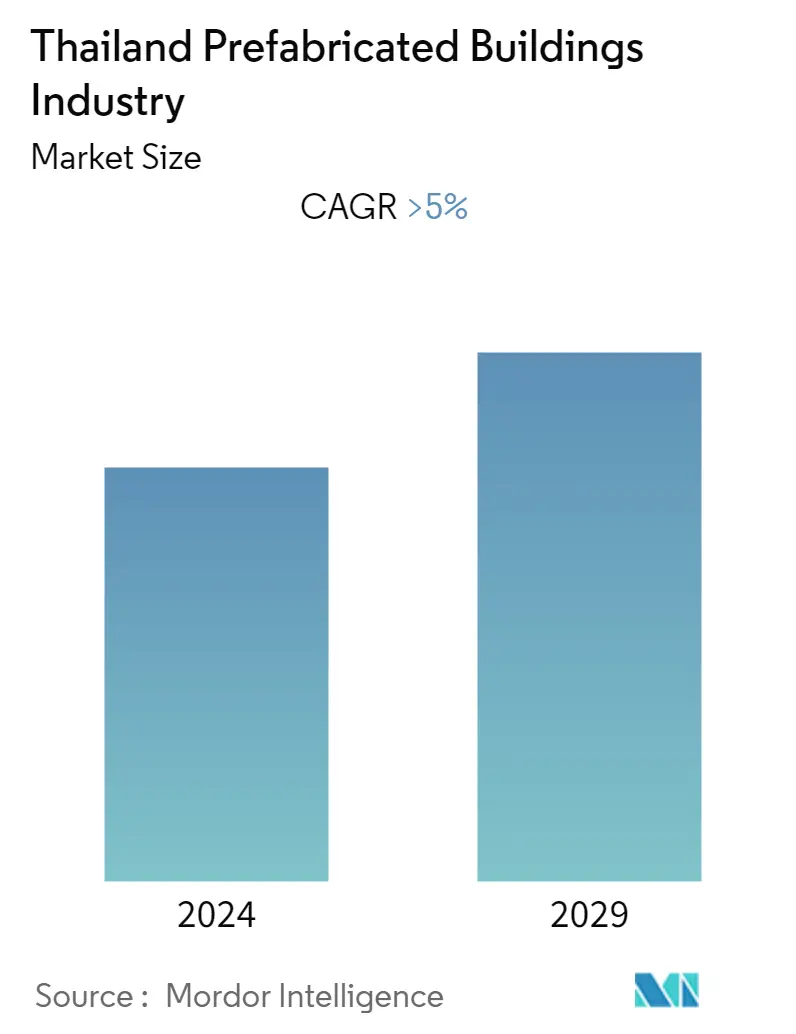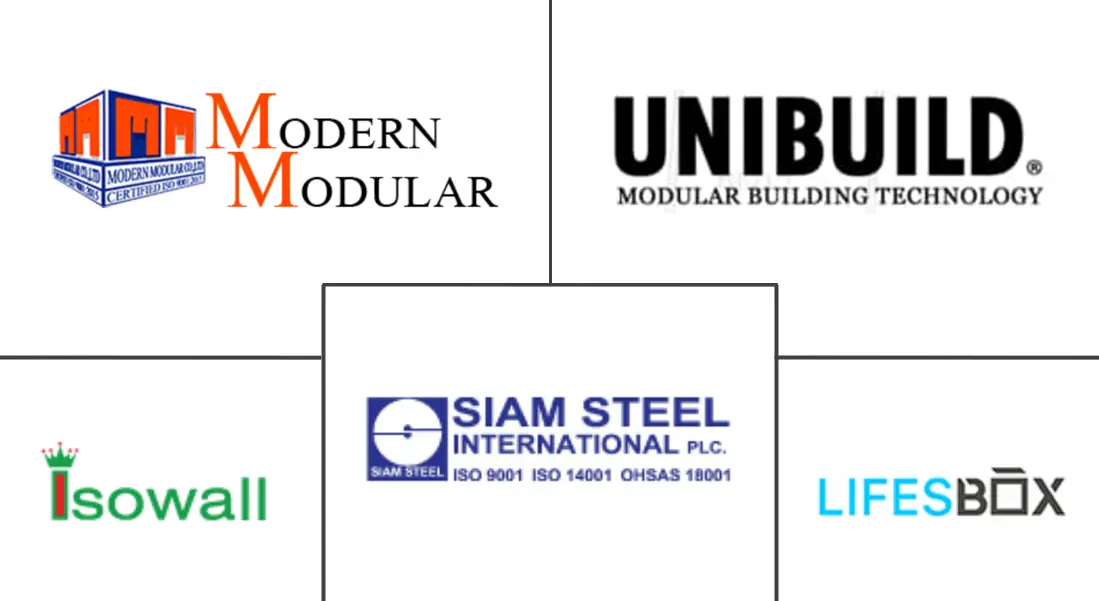Market Size of Thailand Prefabricated Buildings Industry

| Study Period | 2020 - 2029 |
| Base Year For Estimation | 2023 |
| Forecast Data Period | 2024 - 2029 |
| Historical Data Period | 2020 - 2022 |
| CAGR | > 5.00 % |
| Market Concentration | Low |
Major Players
*Disclaimer: Major Players sorted in no particular order |
Thailand Prefabricated Buildings Market Analysis
The Thailand prefabricated buildings industry is estimated to register a CAGR of greater than 5% during the forecast period (2023-2028).
- The construction industry in Thailand took a hit due to the pandemic. Residential Construction investment (accounting for 50% of the total private construction value) value contracted by 1.8%, in line with the number of newly registered completed residential projects in Bangkok and its vicinity and the four major regional provinces (Chiang Mai, Chonburi, Khon Kaen and Phuket) in 2021, with a 14.2% decrease in overall due to property developers delaying the opening of new projects in both low-rise and condominium projects, consumer purchasing power stagnating severely following the economic recession and the emergency law temporarily halting the construction in some construction camps, especially Bangkok and its vicinity, with some migrant and provincial workers leaving the construction site and not returning to the area altogether. As a result, many construction projects were postponed, impacting the prefab buildings sector as well. However, commercial buildings Construction investment increased by 3.8% in 2021, partly driven by the expansion of investments in factory construction and office buildings in industrial estates, especially the EEC.
- Prefabrication plays an important role in the modern world of every building today. In Thailand, Prefabs are gaining popularity in the commercial buildings and residential buildings sectors. In Thailand, prefabricated building systems have been recognized as one of the alternatives that increase the speed of construction. Prefabrication for residential construction has been used in Thailand for less than two decades, but it has grown very fast in the past five years.
- Thai developers see prefabrication as the future and are ready to invest more in this type of construction. Recently, many new developers and contractors have switched from traditional buildings to prefabricated buildings to adapt to this new trend in the Thai residential market. Due to the shortage of skilled workers and the quality control of construction work, real estate operators in Thailand have turned to "precast concrete parts systems" in various types of construction work, especially housing projects and high-rise building construction, in order to quickly deliver quality work to customers.
- In December 2022, Sansiri - a construction company in Thailand - expanded its precast factory to full capacity. The production capacity for precast concrete used in residential construction increased to 5,000 units/year from the previous 3,500 units/year under the total investment budget of THB 2,500 million (USD 76.22 million).
- The outlook of the Thailand prefabricated buildings market looks positive considering the increasing popularity of prefab construction and increasing construction investments. Some of the factors that constrain the growth of the prefabrication buildings industry in Thailand include high initial cost, high-cost pressure without appropriate economic scale effects, lack of regulations addressing prefabricated construction practices, and others.
Thailand Prefabricated Buildings Industry Segmentation
Prefabricated buildings (also known as prefabs) are manufactured offsite and transported to the location for on-site assembly. This report covers market insights, such as market dynamics, drivers, restraints, opportunities, technological innovation, and its impact, porter's five forces analysis, and the impact of COVID-19 on the market. Additionally, the report provides company profiles to understand the competitive landscape of the market.
The Thailand Prefabricated Buildings Industry is Segmented by Application (Residential, Commercial, and Other Applications (Infrastructure and Industrial)). The report offers market sizes and forecast for Thailand Prefabricated Buildings Industry in value (USD Billion) for all the above segments.
| By Application | |
| Residential | |
| Commercial | |
| Other Applications (Infrastructure and Industrial) |
Thailand Prefabricated Buildings Industry Size Summary
The Thailand prefabricated buildings market is poised for significant growth, driven by increasing adoption in both commercial and residential sectors. Despite challenges posed by the pandemic, such as delays in project openings and economic downturns affecting consumer purchasing power, the market has shown resilience. The shift towards prefabrication is seen as a strategic response to labor shortages and the need for quality control in construction. Thai developers are increasingly investing in prefabricated systems, recognizing their potential to expedite construction processes and enhance project quality. This trend is supported by the expansion of precast concrete facilities, such as those by Sansiri, which have ramped up production to meet growing demand. The market's positive outlook is further bolstered by government investments in infrastructure and transportation projects, which are expected to stimulate both residential and commercial construction activities.
However, the market faces challenges, including high initial costs and the need for regulatory frameworks to support prefabricated construction practices. The impact of global events, such as the Russo-Ukrainian war, has led to increased costs for building materials, which could affect the affordability of prefabricated buildings. Despite these challenges, the market remains competitive, with numerous local and international players vying for market share. Technological advancements and innovations are crucial for maintaining competitiveness, as customers demand continuous improvements in construction processes. The market is expected to grow steadily, supported by ongoing construction investments and the introduction of new projects, which will drive the demand for prefabricated building solutions in Thailand.
Thailand Prefabricated Buildings Industry Market Size - Table of Contents
-
1. MARKET INSIGHTS
-
1.1 Current Market Scenario
-
1.2 Technological Trends in the Market
-
1.3 Supply Chain/Value Chain Analysis of the Prefabricated Buildings Industry
-
1.4 Brief on Different Structures Used in the Prefabricated Buildings Industry
-
1.5 Cost Structure Analysis of the Prefabricated Buildings Industry
-
1.6 Insights on Different Types of Materials used in Prefabricated Buildings Construction
-
1.7 Impact of COVID-19 on the Market
-
-
2. MARKET SEGMENTATION
-
2.1 By Application
-
2.1.1 Residential
-
2.1.2 Commercial
-
2.1.3 Other Applications (Infrastructure and Industrial)
-
-
Thailand Prefabricated Buildings Industry Market Size FAQs
What is the current Thailand Prefabricated Buildings Market size?
The Thailand Prefabricated Buildings Market is projected to register a CAGR of greater than 5% during the forecast period (2024-2029)
Who are the key players in Thailand Prefabricated Buildings Market?
Siam Steel, LifesBox Modular, Thai Isowall Company Limited, Unibuild and Modern Modular Co. Ltd are the major companies operating in the Thailand Prefabricated Buildings Market.

